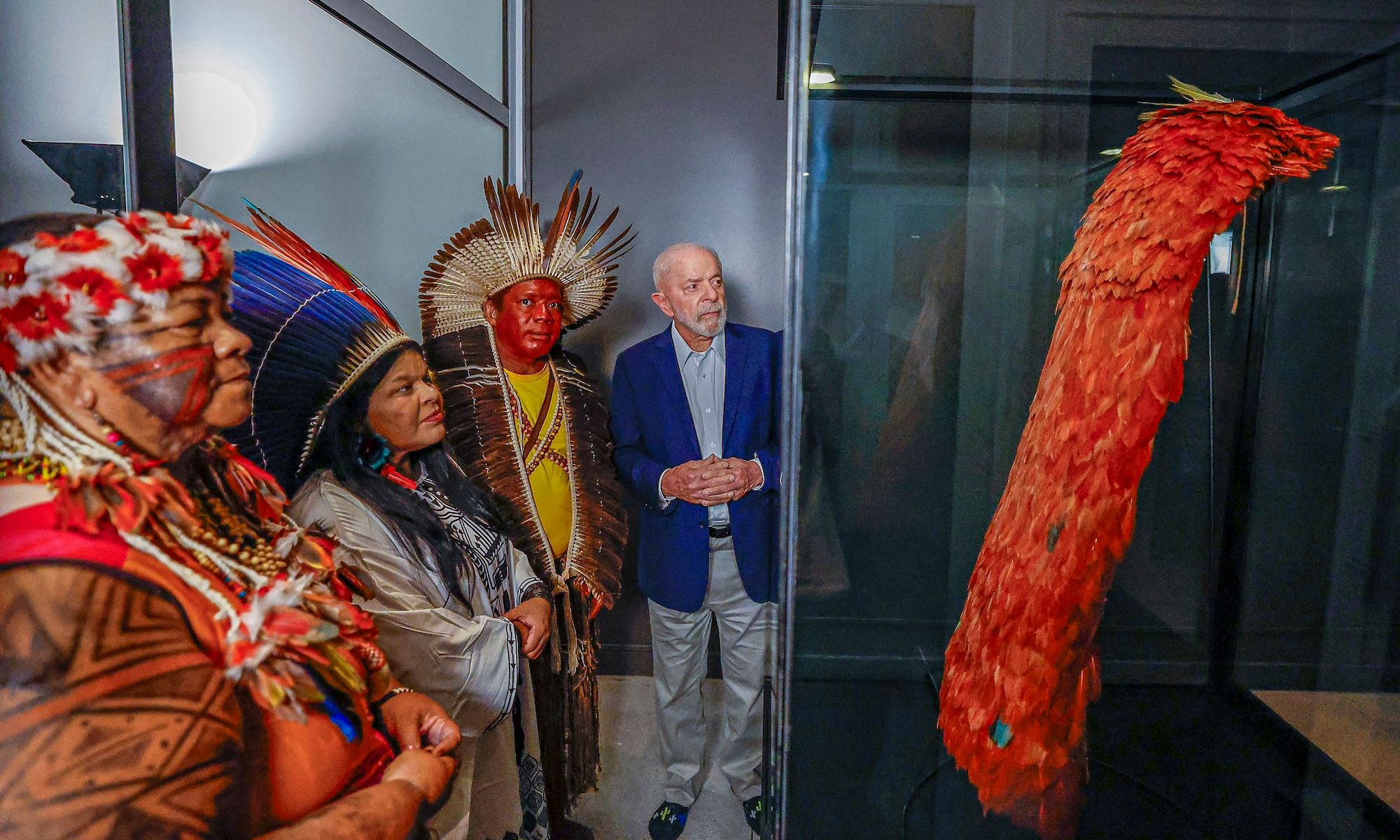Brazilian president Luiz Inácio Lula da Silva and members of the Tupinambá Indigenous community look at the sacred cloak recently returned to Brazil, at the National Museum's Library Photo by Ricardo Stuckert, courtesy Presidency of Brazil
A sacred cloak worn by Indigenous leaders in the 16th century has been returned to Brazil from the National Museum of Denmark. The object’s return, though widely celebrated by Brazil’s Indigenous populations, has sparked a debate over where the artifact should permanently be displayed.
The event to mark the return of the sacred shroud of the Tupinambá Indigenous took place at the National Museum in Rio de Janeiro last week and was attended by President Luiz Inácio Lula da Silva, the minister of Indigenous peoples, Sônia Guajajara, as well as more than 200 members of the Tupinambá people.
“We are facing a time when history is being revised. I see the return of the cloak as the beginning of a process that has everything to establish protocols for access to countless sacred pieces for us, Indigenous people, both inside and outside Brazil,” Guajajara said during the event.
The Tupinambá people agree.
"For us, the Tupinambá people from all over Brazil, it represents a return to our culture, restoration of the demarcation of our territory, not only physical but culturally," Anápuàka Tupinambá tells The Art Newspaper.
Measuring approximately 120cm by 80cm and made of around 4,000 feathers from scarlet ibis birds, the cloak originally belonged to the Tupinambá people, who inhabited various parts of Brazil’s coast in the 16th century. At the time, the Tupinambá population numbered around 1 million.
The artefact is believed to have been taken to Europe by the Dutch around 1644, before they were expelled from Northeastern Brazil by Portuguese colonisers. A few years later, it found its way the National Museum of Denmark, in Copenhagen. The cloak’s return has set off discussions of where exactly this sacred object should be permanently displayed.
“The cloak should have never come to the National Museum. It should never have come to Brazil now,” says Anápuàka. “It should have gone straight to Ilheus in Bahia after the construction of an Indigenous cultural centre was completed. They have temporary custody of the cloak and they are aware of this.”
During his speech last week, president Lula also argued that the National Museum should be considered a temporary shelter, and that conditions should be created for the transfer of the sacred object to the Indigenous territory in Bahia.
The sacred Cloak of the Tupinambá people that was recently returned after nearly 400 years in Denmark Photo by Ricardo Stuckert, courtesy the Presidency of Brazil
“The cloak is in the National Museum, but I hope everyone understands that it does not belong here. I hope everyone understands, and I am sure that we will have the understanding of our governor of Bahia. He has the obligation and the historical commitment to build a space in Bahia that can receive this cloak and preserve it,” the president said.
Leandro Karai Mirim, a member of the Guarani people and communication supervisor at the Museum of Indigenous Cultures in São Paulo, is also in favour of returning the sacred artefact to Indigenous territory.
“The cloak is considered an ancestor of the Tupinambá people. There is a kinship relationship with the cloak. It is a being, with its own spirit, is own spiritual force," Mirim tells The Art Newspaper. He adds that even the most well-intentioned museums in the world will never be able to take care of the sacred pieces as well as the Indigenous. “These museums, for example, will never be able to blow sacred smoke, produced by a Tupinamba Indigenous leader, onto the cloak to call up the spirits.”
According to National Museum officials, the sacred shroud will be one of the highlights in the museum’s reopening exhibitions, currently scheduled for 2026. In a press release, the National Museum acknowledged the importance of the piece to the Tupinambá but did not mention temporary possession or the return of the cloak to Indigenous territory.
“The donation was made between the National Museum of Denmark and the National Museum [of Brazil] on a permanent basis,” a spokesperson for the Brazilian institution tells The Art Newspaper. “We have not yet received any requests for the transfer of the cloak."
The return of the cloak was first announced in June 2023, after a year of negotiations between institutions in Brazil and Denmark. The artefact arrived in Brazil on 11 July, though the ceremony marking its return was held around two months later.
For Brazil’s Indigenous groups, Denmark’s return of the Tupinambá cloak sets a precedent for other sacred artefacts held in foreign collections to be returned. “It will certainly become precedent for other requests to other nations,” says Anápuàka.
Indigenous experts believe there are only 11 cloaks like the one that has just been repatriated in existence. They were produced between the 16th and 17th centuries. Aside from the one that was just returned, they all are abroad, in museums in Italy, Switzerland, Belgium and France.

